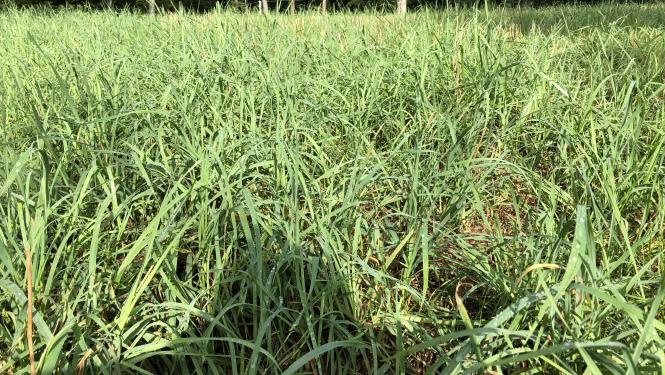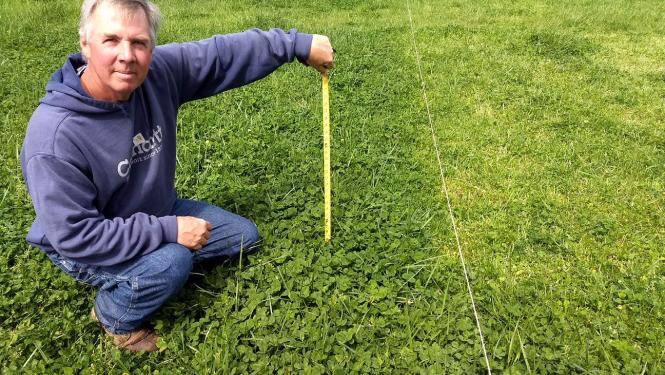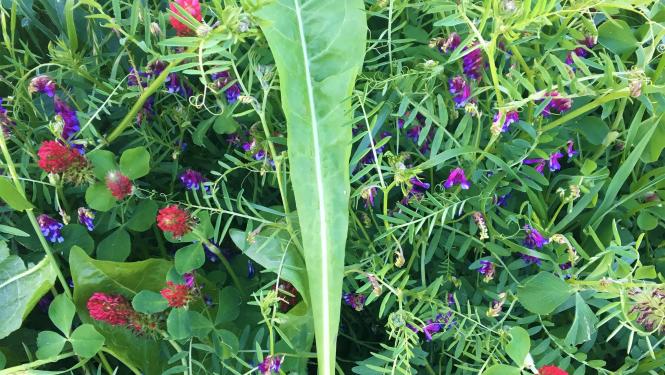Okay, you’ve seen the light. You understand that KY-31 fescue is stealing animal comfort and profitability from you- so now what? Your place, like most in the fescue belt of the Southeast, is covered up in the stuff and you can’t tear up everything at once. Here are a few of many steps you can take to dilute the toxin away:
ADD LITERALLY ANYTHING ELSE.
You’ve heard the anecdote “dilution is the solution to pollution”- this is no different for the toxin in KY-31 fescue. It’s a little easier said than done, but with mindful management you can successfully interseed other grasses, forbs, and legumes.
Other cool season perennial grasses: Orchardgrass and Festulolium
Highlights: Both will increase palatability, sugar content, and animal performance. Orchardgrass is very sensitive to grazing and mowing height, count on 2 cuttings a year or 3 if we have a long spring season. Always leave behind 4”. Festulolium is a little more forgiving to mowing height and can be treated more like fescue. The biggest challenge here will be selective overgrazing- Festulolium is the most palatable CSP around. Without a good rotational grazing plan in place, expect some selective grazing behavior. Thankfully, your mower doesn’t have taste buds so this won’t be an issue in hay fields.

Perennial legumes: Red and White clover
Highlights: Add protein, nitrogen fertility, and palatability to your fields. Low seeding rate, can be drilled or broadcasted in the fall and mid-winter. Struggle with low seeding rates? Check out the Herd Seeder and similar models. Most everybody is familiar with white clover- excellent choice for longevity in grazing pastures. Remember here that the size of clover (ie, the dry matter produced) is directly related to how much it dilutes. That dutch white clover is not doing you any favors and is essentially a weed. Focus on intermediate and ladino white clovers. Red Clover doesn’t get as much attention because of its lesser longevity compared to white clover, but recent research shows that red clover is something to get excited about. Not only does red clover dilute the toxin, but it is very concentrated in a compound that works directly AGAINST the toxin in KY-31 fescue. Two for one, anybody? Mix red and white clovers together to get the most bang for your buck.

Perennial forbs: Chicory and plantain
Highlights: A current favorite in the Southeast AgriSeeds team. Drought tolerant, high protein, low fiber, high mineral, non-stop forage producers. Both need a low seeding rate similar to clovers, can be sown from fall into early spring with great success. Chicory comes in quickly, doesn’t ever seem to quit, and handles drought well. Plantain comes in a little more slowly, but is highly concentrated in minerals and handles overgrazing very well. Once established, you will see these forages rebound after harvesting the quickest. A must have for small ruminant producers or anyone adding weight to livestock.

RENOVATE A FEW ACRES AT A TIME.
There are many examples of producers in the Southeast who have measured how well their calves did or how their pregnancy rates improved when grazing a novel fescue. They captured this by renovating a small part of their farm and keeping a herd separate. Once they saw the results, they never found a good time to put the animals back on the KY-31.
I hear you- “Dang, that’s probably expensive. No way that I’ll be able to pay for that.”
We don’t want to make light of a total farm renovation- it’s not for everyone and is a long process. Interesting analysis from The Alliance for Grassland Renewal shows that renovating 25% of the total farm acreage to a novel fescue would pay for itself in 2.5 years for a spring calving herd or 3 years for a fall calving herd if that 25% needed renovation anyway. On most farms, it is easy to identify a number of pastures that need renovation due to weed pressure, lack of productive forage species, and overall lackluster yield.
Alright, we’ve found a way to help pay for this renovation. What now? It’s time to kill some KY-31 fescue. Start by identifying your worst pasture. Commit to making this your best pasture. Get soil samples, eliminate weeds. If livestock pressure has been excessive, give it a break. Then, spray the fescue. This can be done in the spring or the fall. In our experience, if you follow this spraying with at least one season of annuals you get a better overall fescue kill and develop a healthier soil for the perennial planting down the line. This is commonly referred to as spray-smother-spray. (Herbicides not your thing? You can disk to kill the fescue to kill it as well. Note that this will take some more intensive field preparation before each planting.) You get a lot of bang for your buck here- high quality, high yielding annuals that feed your livestock and help smother out weeds, including KY-31. After a season or more of annuals, it’s time to establish your new perennials and start all over again.
What should I renovate to? What’s the best grass for my pasture? Check out the best uses for each cool-season perennial forage HERE and learn how to select species to feed less hay HERE.
Get excited. You have the chance to transform your forage production, quality, and the health of your livestock.